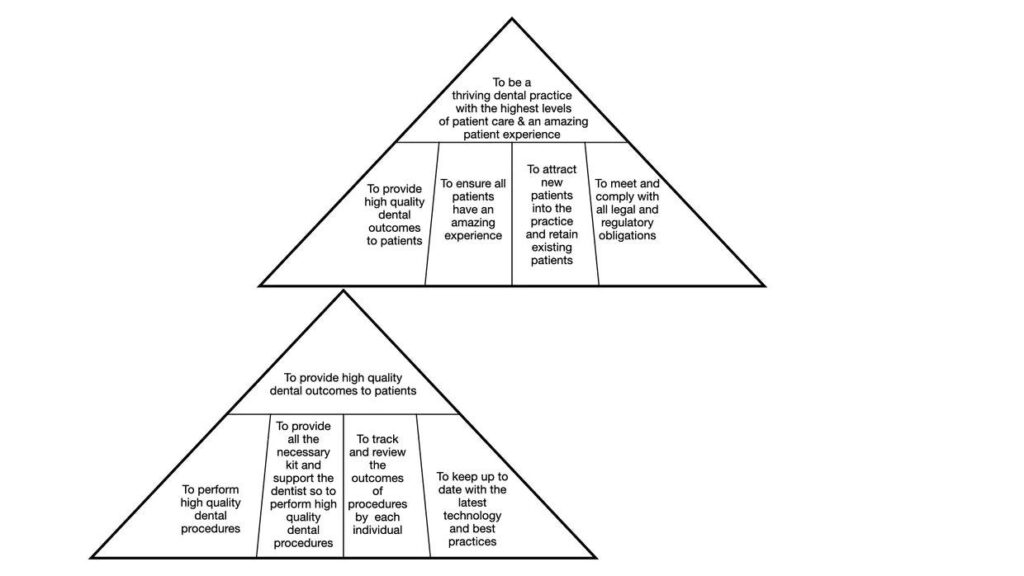Get your ducks in a row
One of the key roles of leadership at a very high level is to get stuff done. It is to ensure that your practice is effectively doing the tasks that need to be done in order to reach the vision and goals that you are striving to achieve. Let’s assume for the moment that the tasks that we are talking about are the right tasks. It is of course critical that these activities are in pursuit of the vision and goals of the practice whilst also living the stated values. Doing a relatively simple analysis of the business and deciding on your key strategies will give you clear focus and direction. What is important is that you then give ownership and responsibility to somebody for making this a reality. The owner or practice principal has overall ownership of the business but you cannot do everything, especially when you are being a dentist as well, so you need to give ownership for the different areas of responsibility.
I think of it as a triangle. At the top, you have the overall vision of the business. This then breaks down into broad areas and then these areas break down further. It is sometimes known as chunking down and even chunking back up depending on what you are describing.

Chunking down
For each of these areas, it must be clear what success looks like. There will need to be clear measures of success marked out over different time periods. What must also be clear is who is responsible for that. In general, I am of the view that dual ownership means no ownership. I have seen numerous occasions where dual ownership doesn’t work as both will look at each other. This is maybe a bit old school but I still think it is important that a single person has responsibility for that area.
This is one area where I do think things should flow from top to bottom so to speak. Think first about what you want to get done based on the overall direction of the business and then give responsibility and roles to individuals based on this. Try to avoid doing it the other way, meaning I have these roles, what am I going to get them to do? Define the roles based on where you want the organisation to go.
In any organisation but particularly in dental practices, there are very historical roles for staff members. These may well still be relevant but I think you can step back from these, consider and challenge all the responsibilities that need to be fulfilled within a practice.
- What are the key strategies that I want to execute?
- Who is most likely to be able to deliver and execute this strategy?
- Who has the right skills and attitudes?
- Who has the capacity?
- What responsibilities do I need to move to somebody else?
- What is being done that no longer needs to be done and is not a priority based on the key strategies for the business?
- What do we need to stop doing?
From this, there will be responsibilities for each position on your team. They are standard to their job and you expect them to perform these. Although these are often assumed and may seem obvious it is really important that there is absolute clarity for the team member about what these are. They must be written down clearly and agreed with the individual. This is the reason for the job description as it is commonly known.
So, these are the ongoing responsibilities that need to be fulfilled for the business to achieve its vision and goals. These must be absolutely clear for everybody so everybody knows their own role and the roles of their team members. In a good team, everybody knows what is expected of each other.
Overall the team must understand that they are all responsible for delivering the overall results of the practice. At the same time, there must be clear and measurable objectives in place for which people are responsible at an individual level as well. Often you will see a job description and it will have a big long list of tasks. This again comes back to how much you want to chunk up or chunk down. If you give very specific tasks then this may help to give the person an idea of what is required from a task perspective but it must be alongside the overall areas of responsibility.
Why is this important?
If you only give the individual specific tasks then it is likely you will have to be on their case to do them and that is all they will do. Once that is done, they won’t do anything else and they will be looking for someone to tell them what to do as they won’t know what their overall responsibility is. Therefore they won’t be thinking about what other activities they could do to fulfil that overall area of responsibility. In addition, when something comes along which is a little outside of the job description they won’t be able to respond appropriately. With everything changing so fast these days this becomes even more relevant. It is not very inspiring for the individual, it doesn’t make use of their potential, it doesn’t engage them in their work and it is hard work for their manager.
On the other hand, if their overall responsibility is clear then staff members will undertake tasks that fit into this role and will not just do the tasks assigned to them. They will be proactive in doing everything possible to be successful in their role and not just do specific tasks.
An example could be as follows:
A receptionist has a list of tasks they perform: answer the phone, greet and sign in patients, take payments, etc.
What are their overall responsibilities?
To provide every customer with a great experience when they connect with the practice either remotely or in person.
How will we know what success looks like?
This will be measured by a customer survey sent to patients asking about this specific part of their experience and by the % of patient enquiries that go through to consultation.
So, what else could the receptionist do to improve this experience, other than the tasks outlined? How do they improve how those tasks are done to fulfil this overall responsibility?
There will then need to be times and structure put in place to review how the individual is progressing against their responsibilities.
So, this is giving you an ongoing structure for how stuff gets done based on the responsibilities that you need to be fulfilled in order for the practice to be successful. On top of this, there are always tasks that come along that need to be done and don’t necessarily fall within the remit of any one person.
In the meantime, what individuals in your team could you give an overall responsibility to as well as just specific tasks? What would that overall responsibility be? Is it aligned with the overall goals and vision of your practice?
What ducks do you need to get in a row?
Article by Jamie Morley Leadership Coach & Owner
Fitting Leadership





